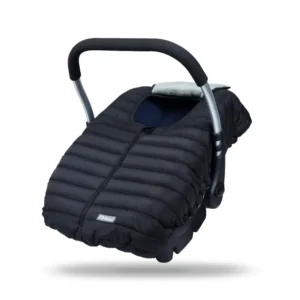When it comes to protecting and enhancing the interior of our cars, car seat covers are often a go-to solution. They serve as a first line of defense against spills, dirt, and general wear and tear. However, an important question arises: Are car seat covers safe?
To answer this, we delved into the aspects of safety, compatibility, and user experiences. Recently, our skilled Axioma technicians displayed vehicles outfitted with high-quality car seat covers, sparking renewed interest in this question.
Safety and Compatibility: Striking the Right Balance

Our exploration starts with the key concern of safety. “Shower cap” style seat covers are particularly noteworthy, as they do not interfere with the harness system of child seats. This ensures that the seat’s safety features remain effective. These covers allow parents to maintain crucial visibility and ensure that the car seat performs its life-saving function without any hindrance. On the other hand, seat covers that go under the child or change the seat’s original padding can compromise safety during a crash and should be avoided.
For other parts of the vehicle, compatibility with built-in safety features like side airbags and inflatable seat belts is crucial. Ensuring a tight fit is important to prevent the covers from shifting during an accident. Seat covers must be designed to accommodate these features without obstructing their function. This compatibility ensures that all safety mechanisms work as intended in case of an emergency, providing passengers with the necessary protection.
The Material Landscape: Benefits and Drawbacks

Car seat covers come in a variety of materials, each with its own pros and cons. Leather, known for its durability and luxurious feel, can be quite expensive and requires careful maintenance, especially in hot or humid conditions. Leather is resistant to wear and tear, making it a long-lasting option. However, it can become uncomfortable in extreme temperatures, heating up under the sun and feeling cold in the winter.
Synthetic materials like neoprene are praised for being waterproof and available in many colors, though they can be costly. Neoprene covers offer excellent protection against spills and stains, making them ideal for families with young children or pets. They also provide a comfortable seating experience, as they can remain relatively cool in hot weather and warm in cooler temperatures.
Cloth and vinyl covers are more affordable options, but they often trade off durability for a lower price. Cloth covers are soft and comfortable, and they come in various designs to match different tastes. However, they are more susceptible to staining and wear over time. Vinyl covers, while easy to clean and maintain, may not provide the same level of comfort and can become sticky in hot weather.
Insights from the Field: Axioma and User Reviews

User reviews of the Upgrade for Cars seat cover reveal a mix of opinions. Some users appreciate the snug fit on models like the Ford KA+ and Vauxhall, noting good value and appearance. These users find that the covers enhance the look of their car interiors while providing necessary protection. Positive feedback often highlights the ease of installation and the overall improvement in car aesthetics.
However, others have reported issues with poor fit, especially on the back seats, and materials that do not hold up well over time, leading to tears and holes. These users express frustration with covers that do not stay in place, creating a disheveled appearance and requiring frequent adjustments. The rapid deterioration of materials, especially in high-traffic areas like the driver’s seat, is a common complaint.
Common complaints include difficult installations and the challenge of finding a true universal fit. Some covers lack pre-made holes for seatbelts and headrests, adding to the inconvenience and overshadowing the benefits of protection and style. This lack of customization can make the installation process cumbersome, especially for those unfamiliar with such tasks.
Should You Use Seat Covers in Your Car?
Given the mixed reviews, the answer is a cautious yes. The key is to choose covers that meet your vehicle’s safety and compatibility requirements and suit your lifestyle needs. Select materials that match your preferences for look and maintenance without compromising on safety. When shopping for car seat covers, it is essential to consider factors such as the type of material, the ease of installation, and how well the cover fits with your car’s specific features.
Our investigation into safety, compatibility, and user feedback highlights that selecting the right car seat cover requires careful consideration and attention to detail. Our Axioma technicians have shown how high-quality covers can enhance both the look and protection of your vehicle’s interior. They recommend paying close attention to the cover’s specifications and ensuring it aligns with your car’s make and model.
User reviews offer valuable insights, guiding us to make informed choices that balance safety and comfort. While some users have had positive experiences with their car seat covers, others have faced challenges. By considering both positive and negative feedback, consumers can make more informed decisions and select covers that best meet their needs.
Practical Tips for Choosing Car Seat Covers
If you’re interested in car aesthetics and care, our blog offers a wealth of information, tips, and reviews to help you maintain your vehicle. From choosing the best best car seat to exploring the latest in car care innovation, we provide comprehensive guidance. Our articles cover a range of topics, including detailed reviews, installation guides, and maintenance tips.
When life’s little accidents mar your vehicle’s appearance, our scratch removal services are ready to help restore its shine. Our experts use advanced techniques to remove scratches and restore the paintwork, ensuring your car looks as good as new. Explore our blog further or contact our experts for solutions that keep your car looking its best.
In conclusion, while car seat covers offer numerous benefits, it is essential to choose them carefully to ensure they meet safety standards and suit your needs. By considering factors such as material, fit, and user reviews, you can find the perfect seat covers that enhance your car’s interior while providing the necessary protection.

Maxwell Harrington is a renowned expert in aesthetic car repair, known for his innovative work at Axioma, where he combines art and advanced technology in SMART car repairs. His expertise in custom paint jobs, body modifications, and use of digital tools for vehicle restoration has made him a pioneer in blending automotive design with state-of-the-art repair techniques.

 Share Post
Share Post


